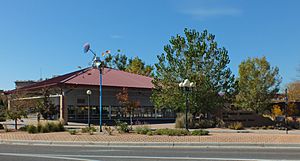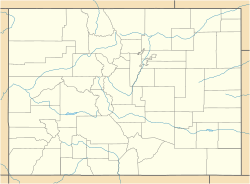El Pueblo History Museum facts for kids

William G. Buckles Archaeological Pavilion
|
|||||||||||||||||
| Established | 1990 | ||||||||||||||||
|---|---|---|---|---|---|---|---|---|---|---|---|---|---|---|---|---|---|
| Location | 301 N Union Ave Pueblo, Colorado |
||||||||||||||||
| Type | Local history museum | ||||||||||||||||
| Accreditation | American Alliance of Museums | ||||||||||||||||
| Nearest parking | On site (no charge) Covered parking available 300-398 W 3rd St Garage |
||||||||||||||||
|
|||||||||||||||||
The El Pueblo History Museum is a cool place in Pueblo, Colorado. It teaches visitors all about the history of Pueblo and the different cultures that have lived there.
At the museum, you can see a replica of an 1840s-style adobe trading post. There's also an archaeological site where the original 1842 El Pueblo trading post was found. This old trading post is so important that it was added to the US National Register of Historic Places in 1996. The museum is part of History Colorado, which helps preserve history across the state.
The museum is also connected to the famous Smithsonian Institution. It is recognized by the American Alliance of Museums (AAM) for its high standards.
History of El Pueblo
The story of El Pueblo and the museum goes back a long time:
- 1803: The United States bought a huge area of land called the Louisiana Purchase. President Thomas Jefferson sent Meriwether Lewis and William Clark on a big adventure. Their job was to explore, map, trade, and learn about this new land.
- 1806: Another explorer, Zebulon Pike, explored the Southwestern United States. His group set up a small outpost near where the Fountain Creek meets the Arkansas River. They tried to climb Pikes Peak. In 1807, they built the first structure in the area, Pike's Stockade. This site became a National Historic Landmark in 1961.
- 1842: The original El Pueblo trading post was built. It was a place where people could trade goods.
- 1848: Business at the fort slowed down because of the Mexican–American War. A peace treaty, the Treaty of Guadalupe Hidalgo, changed how trade worked. Also, the California Gold Rush started, and many people left the area to find gold.
- 1854: Ute and Jicarilla Apache people, led by Chief Tierra Blanco, attacked the fort. After this attack, the fort was left empty.
- 1858: The Pike's Peak Gold Rush brought many new people to the area. They started planning the towns of Pueblo and Fountain City.
- 1860: The town of Pueblo was officially planned and named after the old trading post. Settlers used bricks from the old El Pueblo fort to build their own homes. Over time, the fort disappeared under the growing city.
- 1888: The Farriss Hotel was built right where the old El Pueblo fort used to be.
- 1959: The Colorado Historical Society (now History Colorado) opened the first El Pueblo History Museum. It had a full-size copy of the El Pueblo fort inside an old airport hangar.
- 1980s: The Colorado State University–Pueblo started looking for the exact spot of the original El Pueblo fort. They thought it might be under the Farriss Hotel.
- 1988: Deborah Mora Espinosa became the museum's executive director.
- 1989: A professor named William G. Buckles began looking in the basement of the Farriss Hotel.
- 1991: The city tore down the Farriss Hotel. This allowed archaeologists to dig more. They found signs of the original El Pueblo fort!
- 1992: The El Pueblo History Museum moved to a new building on the same block as the dig site.
- 1996: The rediscovered El Pueblo fort was officially added to the National Register of Historic Places.
- 2003: The new El Pueblo Museum complex was finished. It includes the museum, the William G. Buckles Archaeology Pavilion (which covers the dig site), and a rebuilt trading post that looks like the original.
- 2014: Director Espinosa retired, and Dawn DiPrince became the new executive director.
- 2021: Dawn DiPrince left, and Dianne Archuleta became the new executive director.
What You Can See
The El Pueblo History Museum has many interesting exhibits:
- Borderlands of Southern Colorado: This exhibit explores the history of the border areas in southern Colorado. Part of Pueblo was once part of the Louisiana Purchase. Another part was once Old Mexico and later claimed by the Republic of Texas.
- Children of Ludlow: This exhibit looks at the Colorado Coalfield War and the Ludlow Massacre. It tells the story from the point of view of the children who lived through these tough times.
- Museum of Memory: This exhibit shares the histories of different neighborhoods in Pueblo. Community members tell their own stories about growing up there.
- El Movimiento: This exhibit shows the Chicano struggle for civil rights in Colorado. It was first at the El Pueblo History Museum. Now, you can see it at Pueblo Community College.
- The Bell Rings: This exhibit was about "The Bell Game." This is a yearly football game between two Pueblo high schools: Central High School and Centennial High School. They have played each other since 1892. It is thought to be the oldest ongoing football rivalry west of the Mississippi River.
Fun Programs
The museum offers special programs for kids:
- Hands on History: When Pueblo School District 60 changed to shorter school weeks, the museum started "Hands on History." This program helps parents by giving kids a fun place to go on Friday afternoons. The program grew to be a full day on Fridays. It also has a summer program. This successful program has even expanded to other Colorado cities. These include Trinidad, Fort Garland, Platteville, and Montrose.
See also
 In Spanish: Museo histórico El Pueblo para niños
In Spanish: Museo histórico El Pueblo para niños


